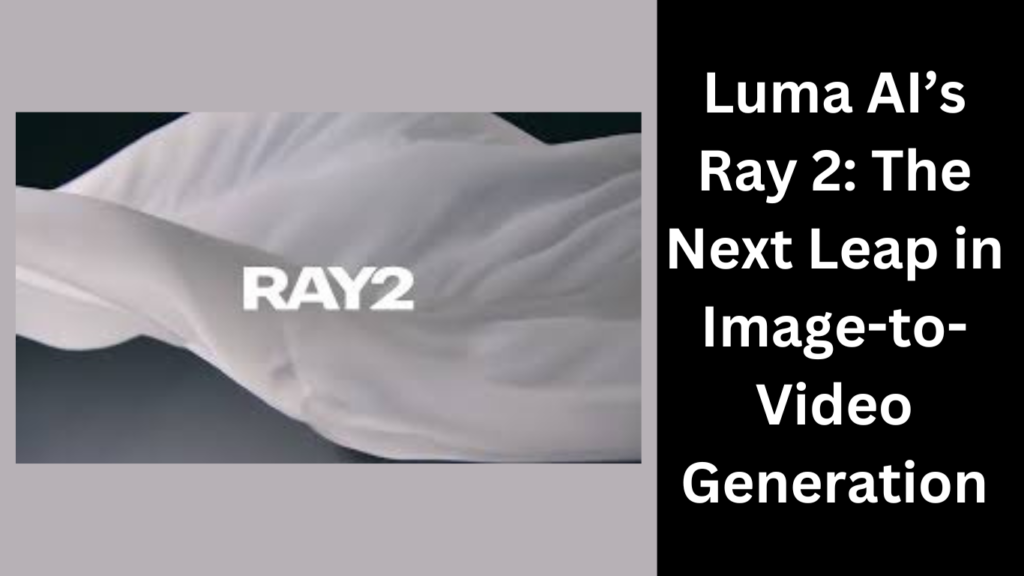Luma AI’s Ray 2: The Next Leap in Image-to-Video Generation

Introduction
The AI-driven video generation space is evolving rapidly, and Luma AI’s Ray 2 is setting a new benchmark. Initially launched for text-to-video generation, Luma has now expanded Ray 2 to support image-to-video generation, taking visual storytelling to the next level.
In this blog, we’ll explore how Ray 2 improves upon previous models, its performance in character consistency, emotional expressions, and camera presets, and whether it truly reclaims its spot as the best AI video generation tool.
1. What is Luma AI’s Ray 2?
Luma AI introduced Ray 2 as an advanced AI video generation model. Initially, it was limited to text-to-video, producing cinematic sequences from text prompts. Now, with image-to-video generation, users can upload an image and let AI bring it to life.
Why is this a big deal?
- Luma was an industry leader in image-to-video AI when it first launched.
- Ray 2 brings back their strongest feature with significant improvements.
- Competes with other AI video models like Sora and Runway Gen-2.
The big question is: Does Ray 2 outperform its competitors? Let’s find out.
2. Key Features of Ray 2
Ray 2’s image-to-video generation introduces some major improvements over the Ray 1.6 model.
✅ Higher Video Quality
- Now supports 1080p video generation (previous models were capped at lower resolutions).
- Better motion rendering, capturing small movements like wind blowing.
✅ Improved Character Consistency
- Maintains character identity across different video generations.
- Perfect for creators who need consistent visuals across multiple scenes.
✅ Enhanced Emotion and Expression Handling
- AI now generates more natural facial expressions.
- Can accurately depict emotions like joy, anger, surprise, and sadness.
✅ Camera Presets for Cinematic Effects
- Users can now apply pre-set camera movements within prompts.
- Makes AI-generated videos look more professional and dynamic.
With these upgrades, Ray 2 is no longer just an experimental tool – it’s a serious contender in AI video creation.
3. Testing Ray 2: Image-to-Video Performance
To understand Ray 2’s full potential, we tested it across different key aspects:
🔹 Character Consistency
A major flaw in AI video generation is character inconsistency – where a character’s appearance slightly changes between frames or different generated videos.
Ray 2 significantly improves on this.
- We uploaded multiple images of the same person and ran different video generations.
- The AI successfully maintained facial features and appearance across all videos.
- Compared to Ray 1.6 and competing models, Ray 2 showed superior consistency.
🔹 Verdict: One of the best AI models for character consistency in videos.
🔹 Facial Expressions and Emotions
Facial emotions are critical for realistic video generation. Many AI models struggle with this, often producing neutral or awkward-looking expressions.
To test this:
- We uploaded close-up images of characters with blank expressions.
- We asked Ray 2 to generate expressions like smiling, sadness, or shock.
- Results were compared against Luma’s previous model (1.6) and Halo Minia Max.
📌 Findings:
- Ray 2 successfully added expressive emotions that looked natural.
- The 1.6 model struggled, often producing awkward or exaggerated expressions.
- Compared to competitors, Ray 2 showed more nuanced emotional accuracy.
🔹 Verdict: Great improvement, though some minor inconsistencies remain.
🔹 Camera Presets
Luma AI now allows users to control camera angles and motion by including camera instructions in prompts.
We tested:
- Zoom-in shots
- Left and right pans
- Overhead shots
📌 Findings:
- The feature works well but is not 100% accurate.
- Sometimes, “left” and “right” were swapped in the output.
- When it works, it creates cinematic effects that make AI videos look professional.
🔹 Verdict: Promising but needs refinement.
🔹 Random Generations (Without Prompts)
To test Ray 2’s pure creativity, we ran random generations without specific instructions.
📌 Findings:
- The model created visually impressive outputs with smooth motion.
- Details like wind movement, background elements, and depth were realistic.
- Sometimes, unexpected distortions appeared, but overall, the results were impressive.
🔹 Verdict: Ray 2 shows strong out-of-the-box creativity.
4. Final Thoughts: Is Ray 2 the Best Image-to-Video AI?
Ray 2 is a major improvement over Luma’s previous models, making it one of the best AI tools for image-to-video generation today.
Pros:
✅ Improved resolution (1080p videos)
✅ Better character consistency
✅ More natural facial expressions
✅ Camera preset options for cinematic motion
✅ More lifelike and creative AI-generated videos
Cons:
❌ Camera presets can be inconsistent
❌ Still lacks critical features like lip sync and subject reference tracking
Final Verdict:
Ray 2 is one of the best AI models for image-to-video generation, but Luma needs to add more features to stay ahead of competitors. If they introduce lip sync, better motion tracking, and subject referencing, they could dominate the AI video generation space.
5. FAQs
1. What makes Luma AI’s Ray 2 better than Ray 1.6?
Ray 2 improves on resolution, character consistency, motion accuracy, and emotion handling. It also introduces camera presets for better cinematic effects.
2. Can Ray 2 generate 1080p videos?
Yes, Ray 2 supports full HD (1080p) video generation, making it suitable for professional content creation.
3. How well does Ray 2 handle character consistency?
Ray 2 is one of the best AI models for maintaining character appearance across multiple video generations, outperforming older Luma models and competitors like Runway Gen-2.
4. Does Ray 2 support lip sync?
Currently, Ray 2 does not support lip sync, which is a missing feature many video creators need.
5. Is Ray 2 free to use?
Luma offers limited free access, but premium options are available for higher-resolution and longer-duration videos.